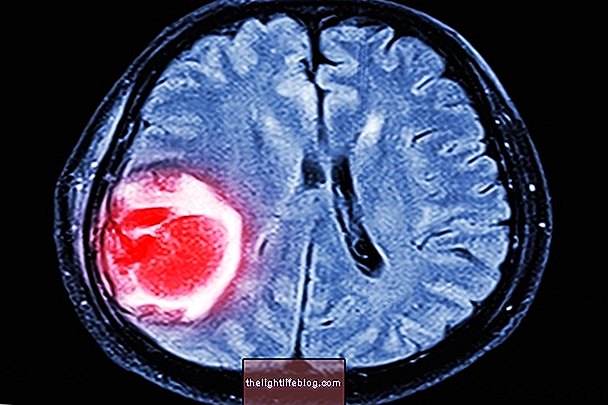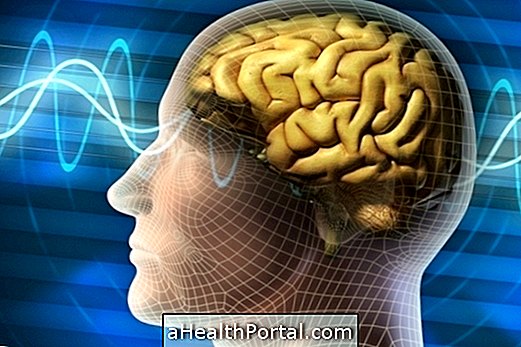Multiple sclerosis is an autoimmune disease in which the immune system attacks the myelin sheath, which is a protective structure that lines the neurons, causing permanent destruction or damage to the nerves, which leads to a communication problem between the brain and the rest of the body.
The signs and symptoms of multiple sclerosis vary and depend on the amount and which nerves have been affected, but they usually include muscle weakness, tremor, tiredness or loss of control of movement and the ability to walk or speak, for example.
Multiple sclerosis is a disease that has no cure, but the treatments available can help control symptoms, prevent crises or delay their progress and should always be referred by a neurologist.

Main symptoms
Multiple sclerosis manifests itself through symptoms that become more evident during periods known as crises or outbreaks of the disease, which appear throughout life, or due to the progression of the disease. Thus, these can be very different, varying from one person to another, and can regress, disappearing completely when carrying out the treatment, or not, leaving some sequelae.
Symptoms of multiple sclerosis include:
- Excessive tiredness;
- Numbness or tingling sensation in the arms or legs;
- Lack of muscle strength;
- Muscle stiffness or spasm;
- Tremor;
- Headache or migraine;
- Lapses of memory and difficulty in concentration;
- Urinary or fecal incontinence;
- Vision problems such as double, cloudy or blurred vision;
- Difficulty speaking or swallowing;
- Changes in walking or loss of balance;
- Shortness of breathe;
- Depression.
These symptoms do not all appear at the same time, but they can decrease the quality of life. In addition, symptoms can be aggravated when you are exposed to heat or if you have a fever, which can spontaneously reduce when the temperature returns to normal.
If you think you may have the disease, select what you are feeling to know your risk:
- 1. Lack of strength in your arms or difficulty walking
No Yes
- 2. Recurrent tingling in the arms or legs
No Yes
- 3. Difficulty in coordinating movements
No Yes
- 4. Difficulty holding urine or feces
No Yes
- 5. Loss of memory or difficulty concentrating
No Yes
- 6. Difficulty seeing or blurred vision
No Yes

How to confirm the diagnosis
The diagnosis of multiple sclerosis is made by a neurologist based on the person's medical history and symptoms, blood tests to help rule out other diseases with symptoms similar to multiple sclerosis, and imaging tests to confirm the diagnosis, such as MRI magnetic field, for example, in which the degradation of the myelin sheath can be verified.
In addition, other tests that the doctor may order are the study of the evoked potentials to record the electrical signals produced by the nerves in response to stimuli and the analysis of cerebrospinal fluid extracted by lumbar puncture that can show abnormalities in antibodies associated with multiple sclerosis and help to rule out infections and other conditions with symptoms similar to multiple sclerosis.
Find out how lumbar puncture is performed.
Who is most at risk
The exact cause of multiple sclerosis is unknown, but some factors can contribute to its onset, such as:
- Be between 20 and 40 years old;
- Being a woman increases the chances of developing multiple sclerosis by two to three times more than men;
- Having multiple sclerosis cases in the family as parents or siblings;
- Having a virus infection like Epstein-barr;
- Having other autoimmune diseases such as thyroid disease, pernicious anemia, psoriasis, type 1 diabetes or inflammatory bowel disease.
In addition, some research associates a higher risk of multiple sclerosis with low levels of vitamin D in the body.

How the treatment is done
The treatment of multiple sclerosis should be done with medications indicated by the doctor in order to prevent the progression of the disease, decrease the time and intensity of the crises and control the symptoms.
In addition, physical therapy is an important treatment in multiple sclerosis because it allows muscles to be activated, controlling leg weakness, difficulty walking or preventing muscle atrophy. Physiotherapy for multiple sclerosis consists of performing stretching and muscle strengthening exercises.
Check out all the treatment options for multiple sclerosis.
Watch the following video and see the exercises you can do to feel better:

Care during treatment
Some important measures during the treatment of multiple sclerosis help to control symptoms and prevent disease progression and include:
- Sleep at least 8 to 9 hours a night;
- Do exercises recommended by the doctor;
- Avoid exposure to heat or hot places, preferring mild temperatures;
- Relieve stress with activities such as yoga, tai-chi, massage, meditation or deep breathing.
It is important to follow up with the neurologist who should also guide changes in diet and to eat a balanced diet rich in vitamin D. Check the complete list of foods rich in vitamin D.
Was this information helpful?
Yes No
Your opinion is important! Write here how we can improve our text:
Any questions? Click here to be answered.
Email in which you want to receive a reply:
Check the confirmation email we sent you.
Your name:
Reason for visit:
--- Choose your reason --- DiseaseLive betterHelp another personGain knowledge
Are you a health professional?
NoMedicalPharmaceuticalsNurseNutritionistBiomedicalPhysiotherapistBeauticianOther
Bibliography
- SAND, Ilana Katz. Classification, diagnosis, and differential diagnosis of multiple sclerosis. Curr Opin Neurol. 28. 3; 193-205, 2015
- 551-563. Multiple sclerosis - etiology and diagnostic potential. Postepy Hig Med Dosw (Online). 71. 0; 2017
- Bassem I. Yamout, Raed Alroughani. Multiple Sclerosis. Semin Neurol. 38. 2; 212-225, 2018
- FAGUY, Kathryn. Multiple Sclerosis: An Update. Radiol Technol. 87. 5; 529-550, 2016
- NHS. Multiple sclerosis. Available in: . Accessed on Dec 22, 2020
- MAYO CLINIC. Multiple Sclerosis: Symptoms & Causes. Available in: . Accessed on 17 Dec 2020

























